The Best Way to Approach B2B Buyer Persona (With the Most Detailed Template)

While many think that marketing is all about creativity, it really is more about data than anything else. And some of the most important information you need is an understanding of who your target customers are.
This is where creating a B2B buyer persona comes in.
Usually, the B2B decision-making and purchase processes are very specific, with tons of intricacies. So, how can you be sure that your buyer persona is going to be effective? Keep reading to find out.
B2B buyer persona explained (with types)
A B2B buyer persona is your idea of what your ideal customer looks like. Think of it like a rough sketch of this made-up person who represents a part of your target audience. Of course, this means they need to have all the traits of your actual real-life client.
This goes deeper than just their age, race, and gender. To build a persona that actually works, you also need to know as many details about their “thought process” as possible. What kind of stuff triggers them? What are their struggles? And other similar questions (we’ll get into those later on).
Typically, any company has multiple profiles like that. As every business is different, it’s hard to say exactly what those are.
Still, there are two categories of business-to-business buyer personas you must keep in mind:
- The first one is based on their roles in the organization. The role of your buyers' persona in the B2B world will influence everything. Selling to a CEO looks nothing like selling to a DevOps. You’ll have to address different struggles and challenges, and communicate different benefits.
- The second is based on behavioral traits that also impact the buying decision. Is your client looking for the best price (e.g., small business owners)? Or is your customer a tech nerd who’s skeptical about most solutions on the market (e.g., a compliance officer)?
Why pay attention to buyer personas?
We won’t be the first ones to tell you that the competition in the B2B marketing scene is just as cutthroat as it gets. So, the more you know about your prospective clients, the easier it is to market to them.
After all, even studies prove how important this is:
- Customer-centric companies rake in 60% more profits than those that don’t bother to be customer-centric. Besides, effective personas can mean a 100% increase in website traffic and a 900% longer visit duration. Pretty impressive, right? But that’s not all.
- It also means a 111% uptick in email open rate and 171% more marketing revenue.
But hang on, aren’t B2B buyer personas generalized?
Sure! But your actual clients are still real people. Yes, they’re “buyers” and “leads,” but still people. While this sounds way too obvious, many forget about this. That’s also why most B2B persona templates out there aren’t effective — they’re just too generic.
But we’ll offer you a solution to that in this guide.
For now, let’s just leave it at this — if you want your customers to trust you with their budgets and business, you need to know how to personalize your approach to each group.
That means knowing which content to use, the best channels, and so on. Even simply figuring out their motivations and needs makes personalization a lot easier.
Knowing exactly who your prospective clients are means that you understand how your product/service fits into their workflow.
As a result, not only do you get an idea of how to improve your offering to solve their pains, but you are also more convincing in your sales attempts.
All in all, you get a much richer relationship with your clients. This is far better for your long-term business growth and brand credibility.
B2B vs. B2C buyers: What is the difference?
B2B and B2C are different in more ways than just one letter of the alphabet. Let’s put these differences side by side:
- The nature behind B2B purchases is different: With the B2C crowd, it’s far easier to get away with impulse purchases. You can’t say the same for B2B buyers since purchases usually involve a lot more people and cost, so they’re much more “logical.”
- There is a whole group of decision makers behind a “B2B buyer”: Your B2C buyer is probably just one person or a family unit. Your business-to-business clients are usually small companies to large enterprises.
- B2B customers have many more things to consider: The B2C clients are typically driven by their preferences and budget. Yet, when it comes to businesses, they have more at stake. So, they have to focus on how relevant, compliant, risk-free, and useful a purchase will be.
That’s exactly why a slogan similar to the one below (“#1 in low price”) won’t really cut it in B2B.
Source: Aldi
- B2B clients have more to lose: If the B2C has buyer’s remorse, they can easily mitigate that. You can’t say the same for businesses that usually have more to lose. For example, you can easily shrug off a bad $20 taco. But a company losing millions just isn't the same (especially if those are litigation costs).
- B2B purchases are typically less frequent: Your B2C buyer might just be a customer you see regularly who comes back for small amounts of the same stuff. B2B purchases will not be as frequent since they involve larger investments and more time (even when it comes to subscriptions).
- The B2B sales cycle is much longer: It’s the norm for the B2C sales cycle to be concluded in minutes (or days if you want to count the shipping timeline). It’s not unheard of for the B2B sales cycle to run into weeks and months.
In fact, the average deal in the B2B world closes in about 6 months.
That’s because a lot more people are involved in the decision-making, and there are many more things to consider. You know, it’s going to be hard to plonk down $325 million for something like this IBM Summit supercomputer.
Source: IBM
To sum it up, the B2C market is generally faster-paced, offers a lot of variety and comes with fewer risks. The B2B industry is more specialized and requires a lot more careful planning before a purchase is made.
Source: X
The average B2B buyer will first do a thorough background check before making any commitment.
They will definitely ask lots of questions about how your product/service can actually improve their existing work process. Plus, they’ll study what changes in their environment will be needed before said improvement is seen.
On top of that, they will likely check how long your business has existed, your credentials, and what other buyers are saying about you, especially their inner circle. You can be sure that their research will be thorough.
Often, B2B companies aren’t the ones to rush and contact you right away. First, they do their homework (i.e., find a couple of solutions on their own). And only after that, you can hear from them.
Source: X
Still, while it might take years before they finally come to a decision and buy, building a good relationship, in the meantime, is key.
That’s where you’ll need a ton of high-quality content to drum up interest and remind them about your brand. You have to be an authority. This is why many B2B companies rely on guest posting and press releases on high-quality sites.
Still, it’s not always convenient to handle this by yourself. So, a good compromise for many is to use a guest posting service. This way, you can focus on running your business and still raise awareness.
Things that can go wrong with B2B customer personas
Do a random Google search for a buyer persona template, and chances are that you will be sorely disappointed.
Those kinds of templates don’t give you enough details. Not even enough to tell what actually influences the buyer’s decisions and how your product/service will fit into their life.
Besides that, numerous businesses fail to do good B2B buyer persona research. Some simply use their gut feeling to create buyer personas. This either leads to over-segmentation or under-segmentation.
With the first one, business owners make the mistake of piling on too many details that don’t add any real value. As for the latter, the problem is the opposite — too many missing details.
This is how you get a buyer persona that is based on stereotypes and won’t really help you. Typically, B2B persona templates lack way too many essentials:
- The goals and pain points are too broad;
- No insights into the organizational structure and everyone involved in the process;
- No understanding of why your business stands out (if it does);
- Lack of the overall market environment;
- Useless demographics, just for the sake of it;
- Not enough competing options considered, etc.
So, what is a good B2B buyer template, then? Here is an example that can serve you for a deeper analysis of your persona.
How to create your buyer personas and what to include (with examples)
This is the moment of truth — time to craft your B2B buyer persona. Based on everything we’ve talked about until now, you understand that you have to be very strategic here. But what should you focus on? These are the most important things you need to take into account:
1. The background info
Your business-to-business persona profile needs all the basic information about your make-believe ideal customer. Yes, before, we mentioned that it wasn’t enough. Still, don’t ignore the basics, either.
So, you’ll need to create a composite profile that includes:
- Roles of all the decision-makers;
- Team and company size;
- Industry and location;
- And demographics that are applicable.
Then, when you cover all these fundamental (and also easy) things, you can go on and enrich your buyer persona with other in-depth details we’ve mentioned above and will elaborate on further.
Basically, most of the B2B personas examples you find online include only these basics. But for us, it will be only the “first slide/page,” so to speak.
Once again, we really encourage you to go beyond all the usual stuff you find in any generic template. While it’s tempting to close this task ASAP, this will serve you greatly later on. Now, let’s continue to check out what else you should include.
2. Include the pain points (be sure to ask the right questions)
You already know that your buyer personas need a list of pain points. Should you just make something up, assuming that you know this all by now? We understand that you’ve done this before on many occasions. But usually, companies still miss something.
Here, you don’t need those vague pain points (e.g., compliance concerns, integration issues, etc.). Sure, they make sense, but they aren’t detailed enough.
Instead, you want to understand the actual workflow your customers are trying to improve and how your solution fits in there.
How do you find this out?
Speak with your current clients. Don’t underestimate the power of a casual chat or that feedback survey mail. If you want to go all in, an interview isn’t a bad idea at all. But what kind of questions should you ask? Here are some ideas:
- What are the trends in your industry, and how do you feel about them?
- What are your immediate goals that will make the most impact on your business?
- What struggles and barriers make it harder to achieve your goals?
- What are the typical rejections you get from your clients?
- What kinds of solutions have you tried in the past, and how would you rate your experience with each one?
- What marketing KPIs does your team use to track progress?
- What would you say is the primary source of the industry-relevant information for you?
It might sound like a lot of questions, but you never know what you might learn. Not only do you get to understand the job they do, but also what matters to them.
For example, you might discover that they have indeed tried a product like yours but couldn’t make it work with their existing system. If you hear an answer like that, elaborate further. What was the struggle?
Here, you might find out that the solution they tried didn’t have a native integration with the XYZ tool, which is vital for them. If that’s the case, this might be an idea for your next sprint.
This deeper research of those “pain points” can actually help you avoid being just another product on the market. Instead, you can release features that solve real issues.
3. Find out what motivates their purchase decisions
Think for a moment about how different your motivations are when buying for your family vs. your business.
When you address some personal needs, you probably focus on whether you like the product, the price, or how your family feels about it. Sometimes, it’s just a purchase made to serve an immediate need.
But when it comes to your business, you probably won’t buy equipment or software based on those same reasons. You’re more likely to be careful not to purchase something you will regret later — regrets are expensive in B2B, after all. Your clients are just the same.
Part of your task while creating the persona for your B2B profile is to understand what triggers the purchase decision and action. You want to know if there is a budget limitation that might influence their choice.
Some might not have any budget constraints but want specific features that improve their efficiency. Others might be more interested in the potential ROI of their purchase.
When you understand their motivations, your next task is to map their buying journey. What does this process look like for them? How long does it take? Who participates at each stage?
By answering these questions, you find out exactly how to personalize your marketing strategy in a way that resonates with them.
Source: Gartner
Here is a little summary of how you could approach this part of your persona analysis:
- Find out your client's triggers. Is there anything on the market that pushes them to find a solution like yours? These can be economic factors, the general business environment, or some internal things like a new launch or a new investment round.
- Understand who makes the decision. Often, in the B2B world, the ones who make the decision don’t really understand the real value of a product because it isn’t what they work with. If that’s the case, you have to know this and think about how you can communicate with these people.
- Try to find out their values. Every business is different, but sometimes, understanding what a company appreciates the most is the key to closing a deal.
Sometimes, it’s still hard to know the motivations your customers have, so exploring this B2B Elements of Value framework by Bain & Company might be a good idea.
Source: Bain & Company
4. Understand who your real competitors are and use this to your advantage
A quick task for you. Drop everything right now and check out who else your clients consider instead of you. Now, don’t skip this point by simply writing down your direct competitors. It goes further than that.
Your potential customers might not only consider solutions similar to yours. In reality, your competition is much broader. It includes:
- Your indirect competitors (obvious);
- In-house solutions (i.e., some businesses might consider solving their issues with internal resources instead of using your offering);
- Leaving things as they are (i.e., other companies might not be exactly convinced they have to tweak anything at all — even if they see value in your product/service).
So, make sure that each of your B2B buyer personas has all these alternatives listed. Here, ideally, you also want to analyze the following:
- What are the “red flags” your clients have when it comes to vendors?
- How do they shortlist their options? What is the defining factor?
- What do they pay the most attention to — cost, customer support, social proof, onboarding, etc.?
Besides, make sure you go through your competitors' marketing copies. Do they just focus on their new shiny gimmicks and features or something deeper? You really want to stand out from them, so put a little more thought into this.
The goal is to figure out and spotlight what your product/service can really do for the customer. But the customer has to need this. This is vital.
In addition to the features, let them know what specific results your product or service can help them achieve. The more you highlight the benefits and outcomes, the more attractive your solution will be.
This is important since it makes it easier for you to create a marketing strategy that applies to your buyer persona's B2B profile.
One thing, though — you have to constantly keep an eye on the context of your market. Not only is it important to be in the loop, but you can also launch some effective real-time marketing campaigns.
5. Don’t get too hung up on the segmentation and perfect research
You’ve done a lot of work to this point. But try not to get bogged down with providing too many specific details for every single section.
If you were able to get a ton of useful information from your interviews, surveys, and chats — great! But if you didn’t have nearly enough information, that's not the end of the world.
Sure, it helps to build detailed client profiles when you have more to go off on. Still, the truth is that your buyer persona does not have to perfectly match a real person or business.
Let's face it — every client is unique, even if those are companies of the same size that operate in the same niche. But you don’t need to create a buyer persona for each of them. So, a little generalization doesn't hurt.
The idea is to understand who you market and sell to better. Your persona simply has to align with the major goals and struggles of your real customers. So, don’t get too stressed if you feel like you can’t collect enough information on every single potential client profile.
6. Get feedback from real buyers
Have you ever heard people say the more personality your buyer persona has, the better? Well, focusing mostly on real buyers for your intel gathering makes it easy to come up with such outcomes. You end up with a more accurate persona that's more effective, too.
But don't be afraid to use your imagination here as well. Picture your buyer persona for B2B as describing a real person. Someone with a background, goals, hopes, social connections, and values.
Another huge thing is to understand who they trust and what they read. If you don’t know where your customers get their information from, your marketing won’t be extremely successful, honestly.
So, make sure you ask your clients whether they use LinkedIn or YouTube. Read Reddit or NYT? Maybe even all of those? You get the idea — find their sources of information.
Pro tip: You might even create a mockup social media profile for this person, use it as they would, and see what recommendations they get based on their interests. Feel free to go big. But hey, this isn’t really necessary.
The more realistic you can make your buyer profile, the easier it will be to grow your sales volume.
7. Prioritize regular updates
One of the biggest mistakes many people make is that they fail to update their buyer persona. They put all that work into creating one and call it a day.
But here's the thing — if you are a software developer, you know that your product needs updates from time to time to meet real needs. It’s the same with your B2B buyer personas. After all, it’s based on real people whose needs evolve.
So, a persona from last year might just not be a good fit today. For one, your clients might have new goals or new challenges (based on the new environment).
After all, there have been a lot of changes recently with AI, for example. So much so that nearly every business is looking for how to take advantage of the new tech.
Okay, that sounds great. So, how often should you update your buyer personas, then? There is really no hard and fast rule here, but many experts recommend doing so every year at least.
Normally, you also do a buyer persona update each time you rebrand your company (unless your rebranding is just visual). The same goes for when you make changes to your product/service.
Did your organization merge with another business? Then, that's definitely a good time to update your persona.
Finally, you want to pay attention to the economic landscape. Sometimes, there might be an event that has a far-reaching impact on your industry. In that instance, it can be a natural trigger for you to update your buyer personas as well.
It does sound like a lot of work, doesn't it? But it's important that you don't skip this step. Chances are, your competitors won't. They are probably watching for any slip-up you make so they can snag your clients. So, don't give them a chance.
Instead, invest in managing your online presence and building a stronger brand reach. This will definitely make it harder for your opps to beat you.
8. Come up with a relevant marketing strategy
Guess what? There is a big idea behind all that effort in creating a buyer persona.
It’s all so you can come up with the perfect persona-based B2B marketing strategy. Now that you know a lot about your buyers, create a marketing plan that aligns with their personalities.
Your marketing strategy should highlight your expertise in your niche — yes. But even more importantly, it should show an empathetic understanding of your customer’s struggles. The more your message resonates with them, the more likely they are to buy from you.
Source: Cooler Insights
You also want to make sure that your efforts are well-spread through the marketing funnel. Since there are different kinds of search intent, your content will have to match each one:
- So, for those seeking some general information, a how-to guide would work.
- Then, for those already comparing their options, you want to provide case studies and testimonials. You know, the kind of content that highlights the value of your products.
- What about when they are finally ready to buy? You want to make sure that you also have content that explains the buying, onboarding, and troubleshooting process.
Conclusion
Congratulations on sticking with us this far! At this point, you are a pro at creating a B2B buyer persona. Now, you understand a little bit better why those generic approaches to building your persona don’t work.
Overall, it’s important to do as much research as possible so that your customer profile looks more like your real buyers. Still, be careful not to be obsessed with getting every little detail right.
When in doubt, just follow the template we’ve shared here and the process we’ve discussed. The main idea is to focus on knowing what makes your clients tick. Figure out how your products or services can help them hit their goals and communicate that.
Customers will always have many options. But you will be their preferred choice if you take the time to show you understand them. This will definitely strengthen your relationship and lead to more revenue for your business.



